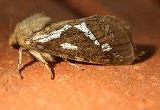
Korscheltellus
Encyclopedia
Korscheltellus is a genus of moth
s of the family Hepialidae
. It consists of two widespread species, the familiar Common Swift
(K. lupulina) of Europe
and the Conifer Swift
(K. gracilis) of Canada
and the eastern United States
. K. gracilis has been recorded feeding on the roots of Quaking Aspen
, White Spruce
and Yellow Birch
but is especially associated with Balsam Fir
and Red Spruce
. It is considered a major pest of these two species.
Moth
A moth is an insect closely related to the butterfly, both being of the order Lepidoptera. Moths form the majority of this order; there are thought to be 150,000 to 250,000 different species of moth , with thousands of species yet to be described...
s of the family Hepialidae
Hepialidae
The Hepialidae is a family of insects in the lepidopteran order. Moths of this family are often referred to as swift moths or ghost moths.-Taxonomy and systematics:...
. It consists of two widespread species, the familiar Common Swift
Common Swift (moth)
The Common Swift is a moth of the family Hepialidae. It was previously placed in the genus Hepialus. It is a common, often abundant European species....
(K. lupulina) of Europe
Europe
Europe is, by convention, one of the world's seven continents. Comprising the westernmost peninsula of Eurasia, Europe is generally 'divided' from Asia to its east by the watershed divides of the Ural and Caucasus Mountains, the Ural River, the Caspian and Black Seas, and the waterways connecting...
and the Conifer Swift
Conifer Swift
The Conifer Swift Moth is a swift moth considered a forest pest in eastern and central North America, from Canada south to North Carolina. Larvae feed primarily on roots of evergreen trees, and are weakly polyphagous, able to survive on deciduous trees but preferring Balsam fir and red spruce...
(K. gracilis) of Canada
Canada
Canada is a North American country consisting of ten provinces and three territories. Located in the northern part of the continent, it extends from the Atlantic Ocean in the east to the Pacific Ocean in the west, and northward into the Arctic Ocean...
and the eastern United States
United States
The United States of America is a federal constitutional republic comprising fifty states and a federal district...
. K. gracilis has been recorded feeding on the roots of Quaking Aspen
Aspen
Populus section Populus, of the Populus genus, includes the aspen trees and the white poplar Populus alba. The five typical aspens are all native to cold regions with cool summers, in the north of the Northern Hemisphere, extending south at high altitudes in the mountains. The White Poplar, by...
, White Spruce
White Spruce
Picea glauca is a species of spruce native to boreal forests in the north of North America, from central Alaska east to Newfoundland, and south to northern Montana, Minnesota, Wisconsin, Michigan, upstate New York, Vermont, New Hampshire, and Maine; there is also an isolated population in the...
and Yellow Birch
Yellow Birch
Betula alleghaniensis , is a species of birch native to eastern North America, from Newfoundland to Nova Scotia, New Brunswick, southern Quebec and Ontario, and the southeast corner of Manitoba in Canada, west to Minnesota, and south in the Appalachian Mountains to northern Georgia.It is a...
but is especially associated with Balsam Fir
Balsam Fir
The balsam fir is a North American fir, native to most of eastern and central Canada and the northeastern United States .-Growth:It is a small to medium-size evergreen tree typically tall, rarely to tall, with a narrow conic crown...
and Red Spruce
Red Spruce
Picea rubens is a species of spruce native to eastern North America, ranging from eastern Quebec to Nova Scotia, and from New England south in the Adirondack Mountains and Appalachians to western North Carolina.-Physical description:...
. It is considered a major pest of these two species.

